
The dingiso, also known as bondegezou, is a species of tree-kangaroo endemic to Papua Province central on New Guinea island, in northeastern Indonesia.

The western mountain coati or western dwarf coati is a small procyonid, found in cloud forest and páramo at altitudes of 1,300–4,250 metres (4,270–13,940 ft) in the Andes of Colombia and Ecuador. A population discovered in the Apurímac–Cuzco region of southern Peru has tentatively been identified as the western mountain coati, but may represent an undescribed taxon.

The hog badger, also known as the greater hog badger, is a terrestrial mustelid native to Central and Southeast Asia. It is listed as Vulnerable in the IUCN Red List of Threatened Species because the global population is thought to be declining due to high levels of poaching.
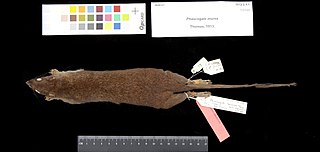
Murexia is a genus of mice-sized dasyure, in the marsupial order Dasyuromorphia. They are found in Papua, Indonesia and Papua New Guinea.

Goodfellow's tree-kangaroo also called the ornate tree-kangaroo, belongs to the family Macropodidae, which includes kangaroos, wallabies and their relatives, and the genus Dendrolagus, with eleven other species. The species is native to the rainforests of New Guinea, and the border of central Irian Jaya in Indonesia. Under the IUCN classification, the species is listed as endangered, which is a result of overhunting and human encroachment on their habitat. They are named after British zoological collector Walter Goodfellow.
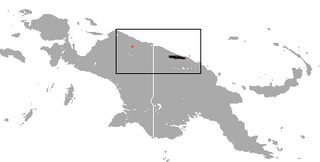
The golden-mantled tree-kangaroo is a species of tree-kangaroo endemic to the Northern New Guinea montane rain forests ecoregion of northern New Guinea island.

Doria's tree-kangaroo is a tree-kangaroo endemic to Papua New Guinea.

The grizzled tree-kangaroo is a small arboreal species of marsupial in the family Macropodidae. It is found in foothill forests of northern and western New Guinea and is indigenous to some of the offshore islands.
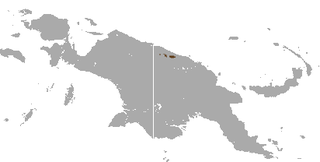
The tenkile, also known as Scott's tree-kangaroo, is a species of tree-kangaroo in the family Macropodidae. It is endemic to a very small area of the Torricelli Mountains of Papua New Guinea. Its natural habitat is subtropical or tropical dry forests. It is threatened by habitat loss and by hunting. The tenkile is listed as endangered due to hunting and logging activities in Papua New Guinea. The tenkile is hunted for its meat, and is the main protein source for the residents of Papua New Guinea. The population of Papua New Guinea has increased in recent years due to improvements in healthcare; therefore increasing need in tenkile meat which means that more tenkiles are being hunted. Additionally, tenkiles are poached for their fur and are captured and sold as a part of the illegal pet trade. Domesticated dogs also hunt tenkiles. Deforestation in Papua New Guinea affects all tree-Kangaroos, however industrial logging that occurs in the Torricelli Mountain Range decreases the species' already restricted habitat. The Torricelli Mountain Range faces additional deforestation due to the timber industry, and the production of coffee, rice and wheat.

The lowlands tree-kangaroo or lowland tree-kangaroo is a species of tree-kangaroo in the family Macropodidae.

The ursine tree-kangaroo is a species of marsupial in the family Macropodidae. It is endemic to the Vogelkop and possibly the Fakfak Peninsulas, West Papua, Indonesia. Other common names for this species include the black tree-kangaroo, the Vogelkop tree-kangaroo and the white-throated tree-kangaroo. It is threatened by habitat destruction and is listed as "vulnerable" by the International Union for Conservation of Nature.

The eastern common cuscus is a species of marsupial in the family Phalangeridae found in eastern Papua New Guinea. Until recently, it was considered conspecific with P. mimicus, and before that also with P. orientalis.

The silky cuscus is a species of marsupial in the family Phalangeridae. It is found in Indonesia and Papua New Guinea.
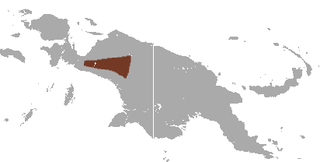
The Weyland ringtail possum is a species of marsupial in the family Pseudocheiridae. It is endemic to the western Central Cordillera of Papua Province, Indonesia. P. caroli is also "known from four localities west of the Star Mountains" and tends to live in montane forest or other hilly areas. Currently the Weyland ringtail is not endangered, but should be "monitored [because] it could rapidly become threatened if either human encroachment or hunting were to increase significantly."

The plantain squirrel, oriental squirrel or tricoloured squirrel is a species of rodents in the family Sciuridae found in Indonesia, Malaysia, Singapore, and Thailand in a wide range of habitats: forests, mangroves, parks, gardens, and agricultural areas. Fruit farmers consider them to be pests.
Bat Conservation International (BCI) is an international nongovernmental organization working to conserve bats and their habitats through conservation, education, and research efforts.
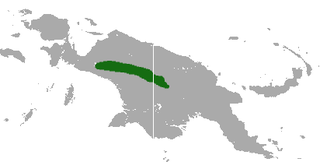
Seri's tree-kangaroo is a species of tree-kangaroo native and endemic to montane forests of west-central New Guinea. Seri's tree-kangaroo was originally considered to be a subspecies of Dendrolagus dorianus, but was elevated to species in 2005 by Groves.
Kloss's squirrel or Kloss squirrel is a species of rodent in the family Sciuridae. It is endemic to northern Sumatra in Indonesia. Population data is insufficient to assess its conservation status according to the IUCN. It is sometimes considered a subspecies of C. notatus.
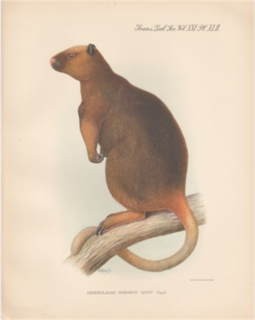
The Wondiwoi tree-kangaroo is a mammal species in the genus Dendrolagus. It was known until recently from a single specimen which was collected in 1928. The only known specimen is a male weighing 9.25 kilograms (20.4 lb). D. mayri was located in the Wondiwoi Peninsula of West Papua at an elevation of 1,600 metres (5,200 ft) within montane forest. It is thought that the Wondiwoi tree-kangaroo could occupy an area of 300 square kilometres (120 sq mi). Global Wildlife Conservation, the wildlife conservation charity, lists the Wondiwoi tree-kangaroo as one of their "25 most wanted lost species".



















